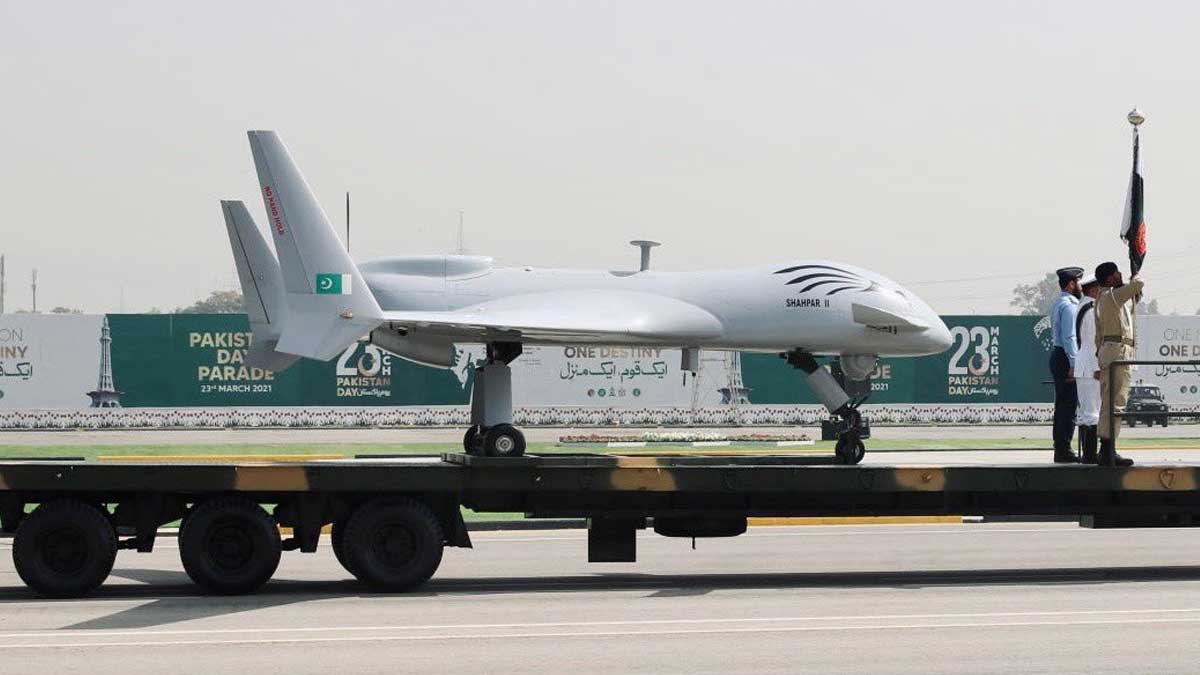The Burraq drone, which Pakistan claims it produced indigenously, has technology from China’s Rainbow series of unmanned aerial vehicles developed by the China Academy of Aerospace Aerodynamics.
NEW DELHI: Until 7 September 2015, Western intelligence agencies believed that just eight countries—the United States, South Africa, France, Nigeria, Britain, Iran, Israel and China—had armed drones that they could use to eliminate human targets. This sense of reality, which ultimately proved to be false, was shattered when the Twitter account of Major General Asim Bajwa, the head of the Pakistan military’s media branch, Inter-Services Public Relations, announced that the Pakistan Army had used a drone to kill terrorists. “The first-ever use of Pak-made Burraq Drone today. Hit a terrorist compound in Shawal Valley killing 3 high profile terrorists,” Bajwa tweeted.
Pakistan thereby joined an exclusive club of three countries—the United States, the United Kingdom, and Israel—that had officially used armed drones to execute targets. The “Burraq” drone, which Pakistan claims has been produced indigenously, fired two missiles and hit a compound in the Wara Mandi area in Shawal valley in North Waziristan, killing three senior leaders of Tehreek-e-Taliban Pakistan (TTP). Once the drone achieved what it did, it came under increased scrutiny by aviation experts, who after careful analysis stated that a major portion of the technology used in it was taken from China’s Rainbow (abbreviated as CH) series of unmanned aerial vehicles (UAVs) developed by the China Academy of Aerospace Aerodynamics, an entity under the China Aerospace Science and Technology Corporation (CASC). Another drone that Pakistan uses, “Shahpar”, experts believe, too, is based on the CH series of Chinese flying machines.
Till the incident on 7 September, “Burraq” (named after the heavenly horse-shaped animal in the Islamic religion that served as a carrier for Prophet Muhammad) was regarded as a drone that was limited to surveillance missions but as it proved later, it was used as a drone that could carry out targeted killing. This incident also brought to the fore Pakistan’s obsession with drones, which is based on the understanding of its military strategists that it needs to have a well-developed and stocked drone arsenal to have a strong enough advantage over its traditional rival India in the coming years, apart from tackling the “threat” from its Western borders.
As per global watchers, Pakistan, at this stage, is “well ahead” of India as far as having military drones is concerned, primarily because of the liberal help that it receives from China and Turkey; a realization that has not been missed by the South Block in Delhi.
The signing authorities in India are now readily signing files that seek permission to invest in military drone technology, as The Sunday Guardian recently wrote (Indian Army gets battle ready to face border challenges, October 30, 2022).
Intelligence developed by those who track the troika of Pakistan-China-Turkey (the latter two nations are on the forefront in developing military drone technology) believes that the three are working tightly on multiple drone-related technologies and in the coming years, will easily move ahead of the United States which so far enjoys monopoly as far as these drones are concerned.
Data accessed by The Sunday Guardian shows that Pakistan in recent years has imported the S-300 series of UAVs that have been manufactured by the Nanjing Research Institute of Simulation Technology, China, and can be used for multiple purposes, including reconnaissance and as an armed missile that can fly at a speed of 900 km per hour for one hour. Similarly, it bought the Germany-based Rheinmetall-manufactured LUNA drone system in May 2021.
In the coming months, the use of these drones is likely to be on display, as Pakistan plans to carry out a sustained military operation on its western borders, which will also present the Pakistan Army with an opportunity to see how these drones perform in real-life situations. In an interesting turn of events, Pakistan has stopped putting out in public the name of the buyer and the seller when it comes to international transactions from March 2021 onwards.
India, official sources said, had multiple other military needs to take care of, and hence it can be argued that military drone technology did not get the attention that it should have got. However, according to them, as elucidated in this report, the situation has changed, with India now investing massively in drone technology. On 1 November, the Indian Army floated a tender to acquire 10 sets of aerial targeting systems with a minimum range of 100 km and an accuracy of 2 meters that can carry high explosives and fly for 2 hours, while loitering in the air at a minimum height of 300 meters.

